Skift Take
Space tourism is no longer a fever dream of wonky scientists and starry-eyed visionaries. Itâs real and itâs here, a fledgling economic powerhouse thatâs still in its awkward adolescence â clumsy, unpredictable but filled with potential.
By Sarah Kopit | October 26, 2024
Twenty years ago, on a clear October morning, the business of commercial space tourism quietly took off in the California desert. Thatâs when Mojave Aerospace successfully launched a manned spaceship that left the Earthâs atmosphere and returned home safely – a first for the private sector.
The flight won the $10 million Ansari XPrize and showed that space travel was no longer confined to government agencies like NASA or Roscosmos in Russia. Instead, commercial enterprise, backed by private financial investment, could make space travel happen.
Among those watching that day was Virgin Group founder, Richard Branson. He saw the seeds of a brand new type of tourism industry. Branson quickly licensed Mojaveâs technology for what would ultimately become Virgin Galactic.
Earthlings â forever born to travel â havenât looked back since.
Still, rockets are expensive. And since that launch, very few space tourists have made the journey. But in the next decade, that number is set to soar. Dramatic drops in launch costs, rapid technological advancements, and a surge in private sector investment are turning what was once science fiction into a fast-approaching reality.
Now, Branson is once again on the space tourism scene together with Space Perspective, a company that offers a different, and arguably more serene option to the current offerings.
It wants to take customers to space in a tricked out, (very) high-altitude balloon.
Branson will co-pilot the companyâs first crewed test flight next year alongside founders Jane Poynter and Taber MacCallum. The ride takes passengers 20 miles up, to the edge of space, in an ultra-luxe, pressurized capsule.
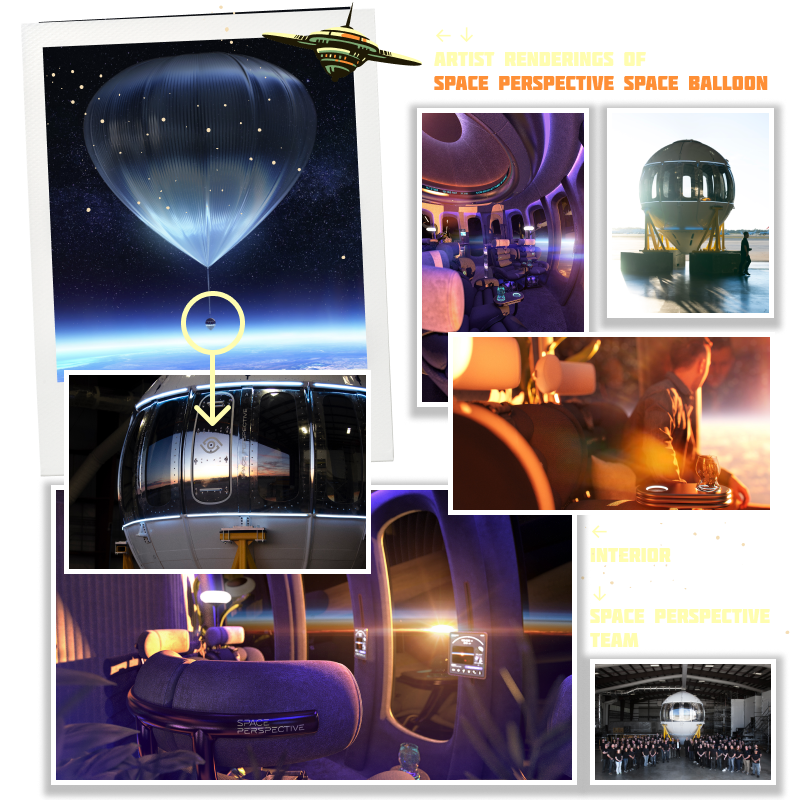

Credits: Space Perspective
So far, Space Perspective says it has $100 million in funding and over 1,800 reservations. Each ride will last about six-hours, with some boasting Michelin-starred cuisine.
But perhaps more importantly, these balloon flights come at a significantly lower price point. Each ride will cost $125,000 per person. Major credit cards, wire transfers, and select cryptocurrencies accepted.
The space economy, currently valued at $630 billion, is projected to soar to an astounding $1.8 trillion by 2035, according to the World Economic Forum and McKinsey. With an annual growth rate of 9%, itâs far outpacing global GDP.
That makes one thing clear: space is about to go mainstream.

Source: Future of Space Economy research
Because It Is Hard
In 1953, long before Sputnik first blasted into the heavens and John F. Kennedy dared Americans to dream, Barron Hilton, son of hotel founder Conrad Hilton and the eventual CEO of Hilton Hotels, had a hospitality vision plucked from the wildest corners of science fiction â he wanted to build a Hilton on the moon. And this wasnât just idle talk or a Hollywood fantasy. He had blueprints sketched out and key fobs created.
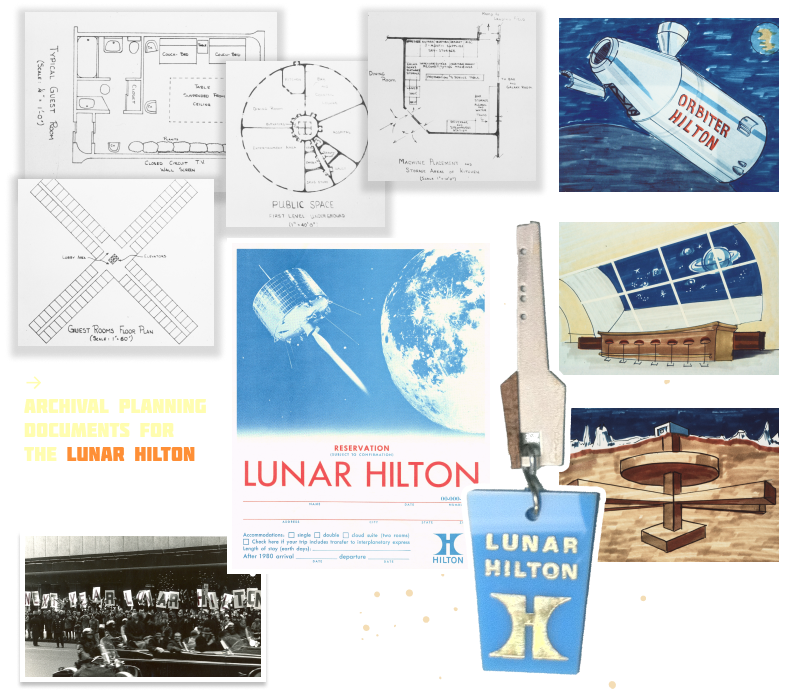

Source: Hilton Hotels
But dreams have a way of running headlong into reality. Decades later, when America finally did plant its flag on the moon, the Lunar Hilton was still earthbound. By then, the nation was entangled in the slow-burning disaster of Vietnam. And as the Cold War deepened, âone small step for man, one giant leap for mankindâ quickly faded from public consciousness. Space had become just another theater for geopolitical maneuvering.
It would take a new century, the next generation, and a very earthborn crisis to reignite commercial space tourism.
New Century, Oldschool Hospitality
After 2000, space travel took a decidedly capitalistic turn. The now-famous space trio of Bezos, Branson and Musk turned their billions skyward, each founding their own space ventures: Blue Origin, Virgin Galactic, and SpaceX. Together, they broke the government’s monopoly and ushered in a new era of private space travel.
But for Hilton Hotels, it was an unexpected, invisible adversary that pulled it back to Barron Hiltonâs original vision of interstellar hospitality.
When the world ground to a halt in 2020 due to the Covid-19 lockdowns, Larry Traxler, Senior Vice President of Global Design at Hilton, and his team suddenly found themselves with some time to think. And it was at that moment when Voyager Space, a tech company that aims to develop commercial space stations, came calling. Voyager had a bold idea: to win the NASA contract to build the replacement for the aging International Space Station.
Voyager named its vision Starlab.
Voyager planned for Starlab to be a permanently crewed station that could host business, scientific, and space tourism ventures. But for that, Voyager knew they needed more than just a functioning station â they needed to create a place where people would actually want to visit..
In short, Voyager needed Hilton to bring hospitality to space.


Source: Hilton Hotels
âWe started thinking through what it might be like for space tourism, when we’re sending up astronauts who have no formal training,â Traxler recalls. âWhat are they going to be looking for?â
The surprising answer? Good zoning.
Traxler and his team plunged into multi-day design marathons with astrophysicists and engineers. âThese guys are brilliant scientists,â Traxler says with a grin. âThey’ve got everything figured out.â
But not quite everything.
âWe start pointing out things like, maybe you don’t want the toilet near the galley ⦠because there are sounds â¦â Traxler laughs. âWe wouldn’t do that in a hotel.â
It was an easy fix. The toilet had been placed near the galley because it was efficient, not because it made sense for human comfort. Voyager moved it away, and Hilton was invited back for the final pitch to NASA at the Johnson Space Center in Houston.
âIt was a three-day session, hundreds of people on calls, hundreds of people in the room going through all the scientific aspects,â Traxler remembers. âAnd they gave us the last 30 minutes to close.â
Hiltonâs pitch was simple but powerful â they emphasized the human side of Starlab. What if the crew quarters were not just functional, but inviting? What if there was a spot for travelers to prop up their iPads and FaceTime with family back on Earth? A galley where people could gather for movie nights? And, of course, a perfect spot for those all-important Instagram shots?
âIt was everything that layers into how we design hotels.â And the result? âThey actually stood up and were applauding at the end,â Traxler recalls, still smiling.
Voyager Space won the NASA contract. Starlab is on track to replace the International Space Station by the end of the decade.


A Celestial Land Grab
For now, the space market is still relatively small. The industry only has a handful of key players and participating space-minded consumer brands â but theyâve got deep pockets and even deeper ambitions.
Anousheh Ansari, now the CEO of the XPrize Foundation, was the first woman to travel into space as a private citizen and space tourist. She spent 11 days orbiting 250 miles above the Earth aboard the International Space Station.
In an interview with Skift, she recalled the sensation of weightlessness and the first awe-inspiring sight of the Earth from space. While long familiar from photographs, she says the planet took on a new dimension when witnessed firsthand. “Even though it’s an image I’d seen many, many times,” Ansari mused, “when you see it with your own eyes, it sort of becomes real.”
Ansari experienced the Overview Effect, a profound shift in perspective thatâs almost universally reported when seeing Earth from space for the first time.
To her, the planet appeared alive, pulsing with warmth and energy. âIt was palpable,â she told Skift. âI started crying, and then my tears floated in front of me, which made me laugh. I was crying and laughing â it was just an incredible experience.â
Ansari is confident that soon, many more humans will share that extraordinary, perspective shifting feeling.
âââI see a clear path to a big change, a mindset shift about how space can be part of our everyday lives,â says Ansari. âSo not only can we travel to space, but we’ll be able to build businesses in space.â


The most common tourist offerings available now are the multi-million dollar suborbital flights that give travelers a quick hit of space. Think what Jeff Bezosâs Blue Origin offers on its rocket, New Shepard, which just completed its 26th flight.
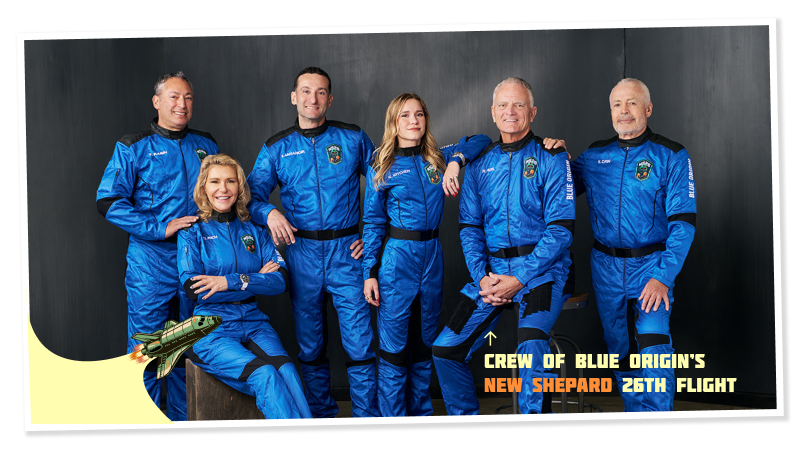

Crew of Blue Originâs New Shepard 26th flight
Source: Blue Origin
In September, SpaceX sent the Polaris Dawn crew into orbit aboard its Dragon capsule, hitting the highest altitude since Apollo and pulling off the first spacewalk by commercial astronauts.
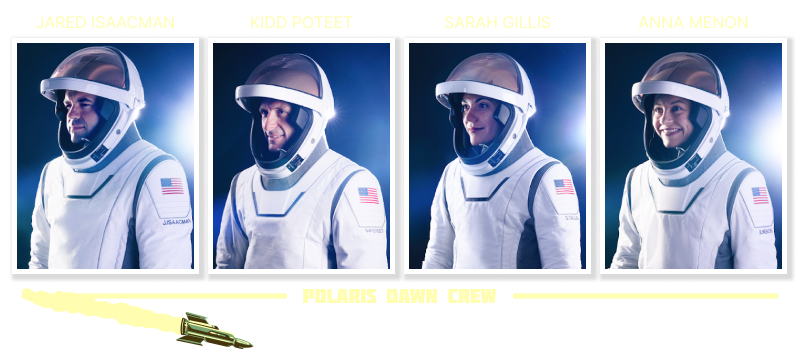

Source: SpaceX
SpaceX also had a breakthrough with its first successful “chopsticks” landing, using mechanical arms to catch the Super Heavy booster after launch. This system could reshape space tourism by cutting costs and boosting launch frequency. By eliminating traditional landing gear and accelerating rocket reuse, it reduces turnaround times between flights. For the space tourism market, this innovation brings SpaceX closer to affordable, mass-accessible space travel.
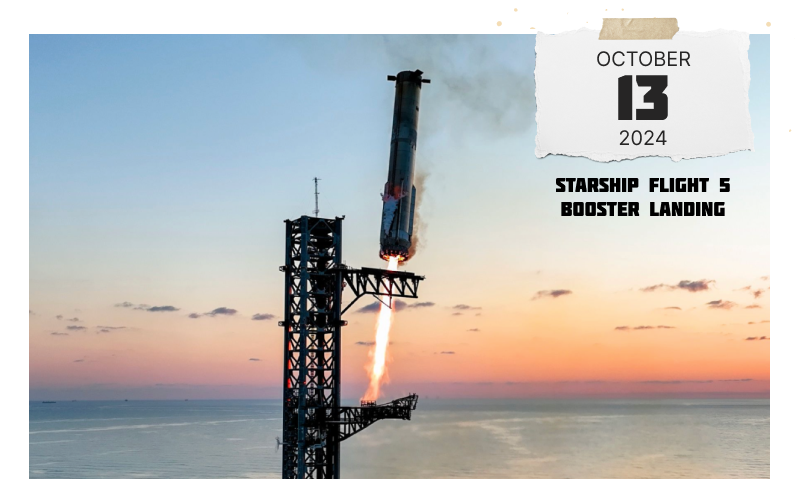

Source: SpaceX
And then there are the brands trying to leverage the cultural zeitgeist of space. Omega, which supplied watches for NASA on the Apollo mission, now has a next generation moon watch. Under Armour created the space suits for Virgin Galactic pilots. Adidas is partnering with the ISS National Lab to test footwear in the extreme conditions of space, designing âfor athletes on and off Earth.â
Over at Prada, the luxury retailer created the space suits for Axiom Space, whose mission includes boosting space tourism. Axiom is ready for all the various sizes and shapes of human bodies, noting the suits have increased sizing and adjustability to accommodate a wider range of the general population.
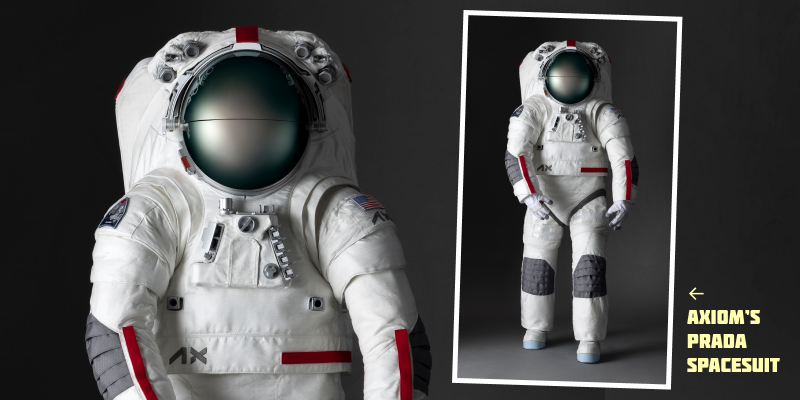

Source: Axiom Space
But the eventual future of space travel and tourism is far broader than any of this. And its success hinges on several key factors: the ability to accommodate people in orbit, evolving regulations and legal frameworks, and the level of demand from wealthy customers.
By 2035, the World Economic Forum projects the space tourism market could reach $4-6 billion annually, driven primarily by luxury stays aboard space stations, with ultra-wealthy individuals eager to experience life beyond Earth.
The suborbital flights, while expected to become more affordable over time, are predicted to account for a smaller slice of revenue, generating $1-$2 billion a year. However, the potential for growth could expand significantly if larger spacecraft like SpaceXâs Starship begin taking more passengers on short orbital trips.


Call Your Travel Space Agent
When it comes to securing a seat on a multi-million dollar spaceflight, the process is far more complex than, say, booking a vacation on Expedia. Instead, eager would-be astronauts will likely find themselves in touch with someone like Roman Chiporukha, CEO and co-founder of SpaceVIP, a luxury travel company that caters to the elite.
Chiporukha saw an opportunity for space-based travel when Axiom sought its help promoting the first all-tourist mission to the International Space Station. With three tickets available at $50 million each, SpaceVIP stepped in.
âEveryone was like, âyouâre crazy, nobodyâs buying a ticket to space,ââ Chiporukha recalls. But by November 2020, SpaceVIP connected Axiom with the third passenger for the mission. In the process, Chiporukha identified a significant gap in the information available about private space travel.
âNobody in the general public had any idea what was going on in space tourism,â he says, pointing out that websites for companies like SpaceX and Virgin Galactic focus on lofty ideals but skimp on practical details like availability, location, or price. âWhat do I tell my wife? How long wonât I be home for?â he jokes. Thatâs when SpaceVIP created a platform that aggregates all space tourism experiences into one place, making the logistics of space travel more accessible.


As for the space balloons, Space Perspectiveâs founder told Skift sheâs bullish on adding a bit of luxury to what will still be an expensive process. âMost people want to go on a safari and have that extraordinary experience, but frankly, want to also have their gin and tonic in the evening,â she says. âSo we get to do that in space. You will be able to have your beverage of choice during this flight. You will be able to go with your loved ones. It will completely change how people view space travel.â
High Risk, High Reward
As private companies push the boundaries of space tourism, the risks associated with spaceflight are unlikely to disappear. Take the extended stay of NASA astronauts Butch Wilmore and Suni Williams aboard the ISS.
Originally intended to last just over a week, their mission has stretched into months due to a series of technical failures aboard Boeingâs Starliner spacecraft. NASA and Boeing had to return the Starliner to Earth without its crew. Now, the two astronauts are set to return in early 2025 aboard SpaceXâs Crew Dragon, demonstrating how unpredictable and fraught with challenges space travel remains.
An Interdependent Planet
As the space travel industry grows, so does the scrutiny over who truly benefits. Critics point to the environmental impact of frequent rocket launches, which release vast amounts of carbon dioxide and pollutants, potentially undoing years of climate progress.
Others highlight the stark wealth disparity it represents. There’s also an ethical debate about whether resources being funneled into space tourism could be better spent addressing critical issues on Earth, such as poverty.
Roman Chiporukha is quick to point out that human lives are profoundly affected by technology that is the direct result of space-related science.
â50% of the technological innovation that we take for granted comes from space technology,â he says. âLike this phone call or the Uber that brought you to work or your food delivery, or anything that’s steeped in GPS.â
Similarly, Ansari believes the more people who travel to space, the better. She thinks that the overview effect that she felt could lead to a profound change for anyone who experiences it.
âIt makes you care about the entire planet and the interconnectedness that we have to each other. So I think that’s an experience that will be transformative, transformational for anyone.â


Source: NASA
Ultimately, space tourism is more than an economic frontier; itâs a testing ground for how humanity navigates the challenges and opportunities of a shared, global future. Whether it leads to a new era of sustainability and human unity â or simply becomes another stage for economic disparity â remains to be seen. But for Ansari, as someone whoâs been there, the future looks positive.
Sarah Kopit is editor-in-chief at Skift. Contact her at [email protected]
Graphics by Beatrice Tagliaferri
Have a confidential tip for Skift? Get in touch

